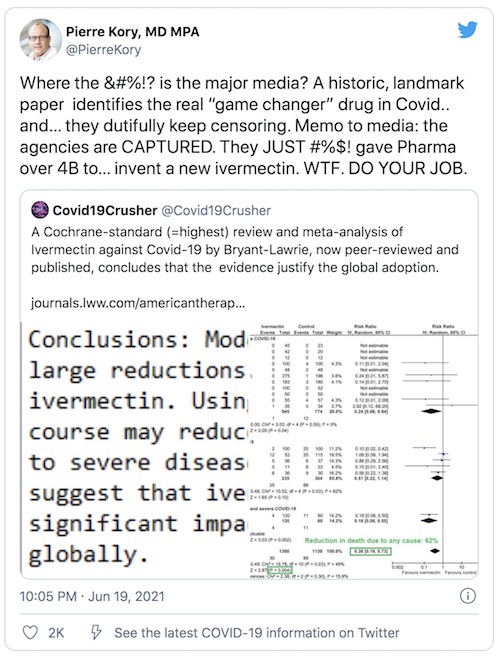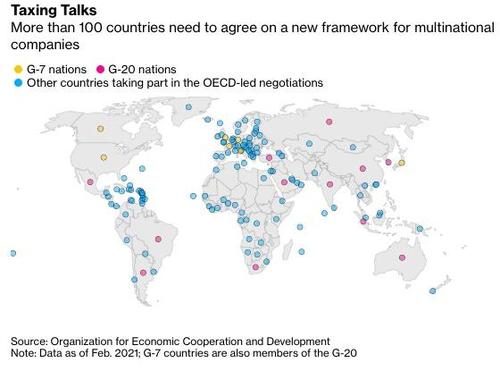
Pablo Picasso Femme au Béret et à la Robe Quadrillée (Marie-Thérèse Walter) 1937

See 1st article below


American Journal of Therapeutics
• Ivermectin for Prevention and Treatment of COVID-19 Infection (AJT)
Therapeutic Advances: Meta-analysis of 15 trials found that ivermectin reduced risk of death compared with no ivermectin (average risk ratio 0.38, 95% confidence interval 0.19–0.73; n = 2438; I2 = 49%; moderate-certainty evidence). This result was confirmed in a trial sequential analysis using the same DerSimonian–Laird method that underpinned the unadjusted analysis. This was also robust against a trial sequential analysis using the Biggerstaff–Tweedie method. Low-certainty evidence found that ivermectin prophylaxis reduced COVID-19 infection by an average 86% (95% confidence interval 79%–91%). Secondary outcomes provided less certain evidence. Low-certainty evidence suggested that there may be no benefit with ivermectin for “need for mechanical ventilation,” whereas effect estimates for “improvement” and “deterioration” clearly favored ivermectin use. Severe adverse events were rare among treatment trials and evidence of no difference was assessed as low certainty. Evidence on other secondary outcomes was very low certainty.
Conclusions: Moderate-certainty evidence finds that large reductions in COVID-19 deaths are possible using ivermectin. Using ivermectin early in the clinical course may reduce numbers progressing to severe disease. The apparent safety and low cost suggest that ivermectin is likely to have a significant impact on the SARS-CoV-2 pandemic globally.

The Journal of Antibiotics
• The Mechanisms Of Action Of Ivermectin Against SARS-CoV-2 (JoA)
Although several drugs received Emergency Use Authorization for COVID-19 treatment with unsatisfactory supportive data, Ivermectin, on the other hand, has been sidelined irrespective of sufficient convincing data supporting its use. Nevertheless, many countries adopted ivermectin as one of the first-line treatment options for COVID-19. With the ongoing vaccine roll-out programs in full swing across the globe, the longevity of the immunity offered by these vaccines or their role in offering protection against new mutant strains is still a matter of debate. The adoption of Ivermectin as a “safety bridge” by some sections of the population that are still waiting for their turn for vaccination could be considered as a “logical” option.
Several doctor-initiated clinical trial protocols that aimed to evaluate outcomes, such as reduction in mortality figures, shortened length of intensive care unit stay and/or hospital stay and elimination of the virus with ivermectin use have been registered at the US ClinicalTrials.gov [7]. Real-time data is also available with a meta-analysis of 55 studies to date. As per data available on 16 May 2021, 100% of 36 early treatment and prophylaxis studies report positive effects (96% of all 55 studies). Of these, 26 studies show statistically significant improvements in isolation. Random effects meta-analysis with pooled effects using the most serious outcome reported 79% and 85% improvement for early treatment and prophylaxis respectively (RR 0.21 [0.11–0.37] and 0.15 [0.09–0.25]).
The results were similar after exclusion based sensitivity analysis: 81% and 87% (RR 0.19 [0.14–0.26] and 0.13 [0.07–0.25]), and after restriction to 29 peer-reviewed studies: 82% and 88% (RR 0.18 [0.11–0.31] and 0.12 [0.05–0.30]). Statistically significant improvements were seen for mortality, ventilation, hospitalization, cases, and viral clearance. 100% of the 17 Randomized Controlled Trials (RCTs) for early treatment and prophylaxis report positive effects, with an estimated improvement of 73% and 83% respectively (RR 0.27 [0.18–0.41] and 0.17 [0.05–0.61]), and 93% of all 28 RCTs.

mRNA-vaccine inventor:
“I know of no data wherein the mean, median, range etc of total amount of spike protein produced in a patient after administration of the COVID genetic vaccine has been defined.”
• Regarding Dosing Of The Covid Genetic Vaccines (Malone)
Regarding dosing of the COVID genetic vaccines (mRNA, recombinant adenovirus) versus the more traditional vaccines (including Novavax). There are some inconvenient truths here. First, the current genetic vaccines (Sanofi, J&J, Pfizer, Moderna) did not undergo the time tested assessments of dose ranging and dose timing clinical studies, to the best of my knowledge. I have direct first person report of how the dose was selected for Moderna (confidential source), and it was basically a SWAG by committee consensus. Personally, for what it is worth, it is my opinion that the current mRNA vaccines selected a dose that was too high, too far up on the sigmoidal dose response curve – so that we may have excess adverse events. Dose selection with vaccines is usually about careful balancing of adverse events with potency/efficacy/effectiveness, with a bias towards safety.
Second big inconvenient truth is that the spike protein is the actual active agent, in terms of eliciting an immune response. And in the case of the traditional vaccines, the dose of spike protein is defined relatively precisely. With the genetic vaccines, it is not (to the best of my knowledge). I know of no data wherein the mean, median, range etc of total amount of spike protein produced in a patient after administration of the COVID genetic vaccine has been defined. Usually, the FDA is quite persnickety about such things, but I am not aware of this key variable having been determined. Therefore, the range and severety of adverse events potentially attributable to the level of expressed spike protein may reflect patient to patient differences in genetic transfer efficiency and subsequent spike expression.

TrialSiteNews should do better than just a discussion about one or two doses. That ship has sailed.
• How Many Lives are Expendable for a 100% Boost in Vaccine Revenue? (TSN)
Looking at the data from Pfizer’s Phase 3 trial, it becomes apparent that they reported a 94.6% relative risk reduction (aka: Vaccine Efficacy) for their two-dose regimen but only a 52.4% relative risk reduction for their single-dose regimen. From that data, it seems clear that the two-dose regimen confers far superior protection and makes the choice between the two regimens clear. This decision to follow a two-dose regimen versus a single dose had monumental consequences for the pace and complexity of the vaccine rollout in the United States and throughout the globe. Obviously, the supply shortage immediately doubled by requiring two doses for every person. This alone would cost countless lives by delaying protection.
However, the logistics of follow-up, reserving second doses, and ensuring the same vaccine is administered for both doses, were all added complexities stacked on top of an already daunting task that stalled the vaccine campaign in its early months. Another significant consequence is that the risk of adverse reactions greatly increased due to the two-dose regimen. Obviously, administering each dose poses some risk of an adverse reaction. However, the second dose is associated with far more frequent and severe reactions compared to the first dose. This is expected because the immune system has already been materially primed and will react robustly to the recognized antigen on the second dose. Now that we’ve seen the dramatic benefits that a single dose regimen would have provided, we’ll delve into the data to determine why the two-dose regimen was chosen, but first, let’s discuss some concepts of how immunity develops over time.
The human immune system is quite complex. It’s well understood that adaptive immunity takes time to develop. It starts to develop in days and ramps up quickly in weeks. However, over longer periods of time, it continues to improve through a process called affinity maturation. The details of these concepts go beyond the scope of this article but, in short, adaptive immunity takes time to develop and continues to improve over many weeks and even months. For this reason, in order to determine the most efficacious dosing regimen, the point in time that the Vaccine Efficacy should be measured must use the same offset from the start of the various dosing regimens being compared. For example, any positive cases that occur greater than 28 days after the first dose for both the single-dose and two-dose regimens would be counted.

400 flights for one covid case.
• South China Airport Cancels 100s of Flights After Covid Case (F24)
The airport in China’s southern city of Shenzhen cancelled hundreds of flights and tightened entry controls Saturday after a restaurant employee tested positive for the Delta coronavirus variant. Anyone entering the facility must show a negative virus test from the last 48 hours, Shenzhen Airport Group said in a statement on its official WeChat social media account. City health officials said a 21-year-old waitress at Shenzhen Baoan International Airport had been infected with the Delta variant of the virus. The woman tested positive during a routine test for airport staff conducted Thursday, they said.
Shenzhen, a mainland Chinese city neighbouring Hong Kong, is home to some of Asia’s biggest tech companies including telecoms equipment maker Huawei and gaming giant Tencent. China on Friday reported 30 new coronavirus cases, including six local transmissions in the southern province of Guangdong where Shenzhen is located. The airport entry restrictions came into effect from 1 pm local time Saturday (0500 GMT). Nearly 400 flights to and from the airport were cancelled Friday, data from flight tracker VariFlight showed. Dozens of flights scheduled for Saturday morning were also dropped.

“..an overreach of power..”
• CDC Can’t Regulate Cruises: Judge (Hill)
A federal judge in Florida on Friday ruled that the Centers for Disease Control and Prevention’s (CDC) coronavirus-era sailing orders were an overreach of power, issuing a preliminary injunction temporarily barring the CDC from enforcing the guidelines. Judge Steven Merryday for the Middle District of Florida in his ruling sided with the Sunshine State in its argument that the “CDC’s conditional sailing order and the implementing orders exceed the authority delegated to CDC.” As a result, Merryday approved Florida’s motion for a preliminary injunction suspending the mandatory guidelines for cruise ships, writing that the CDC is “preliminary enjoined from enforcing against a cruise ship arriving in, within, or departing from a port in Florida the conditional sailing order and the later measures.”
The injunction will stay in place until July 18, at which point the “conditional sailing order and the measures promulgated under the conditional sailing order will persist as only a non-binding ‘consideration,’ ‘recommendation’ or ‘guideline,’” as is the case for other industries such as restaurants, railroads and hotels, according to the ruling. The cruise industry had previously been under a conditional sailing order issued by the CDC since the end of October, under which cruise lines were required to commit to a phased approach of implementing testing and other safety measures before they could start sailing. The conditional sailing order followed the end of the CDC’s no-sail order amid the coronavirus pandemic, and the CDC last month released the final guidance for cruise lines to apply to run test ships with voluntary passengers.

“Our kids have been in masks all day, seven hours a day in school,” Donoho told Fox & Friends on June 17. “The only break that they get is to eat or drink.”
• Florida Lab Finds Dangerous Pathogens On Children’s Face Masks (ET)
A laboratory at the University of Florida that recently analyzed a small sample of face masks, detected the presence of 11 dangerous pathogens that included bacterias that cause diphtheria, pneumonia, and meningitis. Gainesville parents in Florida concerned about the harm caused to their children wearing face masks all day at school in 90 °F weather sent out six masks—five that were worn by children ages 6 to 11 for five to eight hours at school, and one worn by an adult—to be analyzed for contaminants at the University of Florida’s Mass Spectrometry Research and Education Center. Of the six masks, three were surgical, two cotton, and a poly gaiter. Masks that have not been worn and a t-shirt worn at school acted as the control samples.
Five of the masks were found to be contaminated with parasites, fungi, and bacteria, according to Rational Ground. Only one mask was found to contain a virus that can cause a fatal systemic disease in cattle and deer. Other less harmful pathogens that can cause ulcers, acne, and strep throat were also detected. None of the controls were contaminated with pathogens, while “samples from the front top and bottom of the t-shirt found proteins that are commonly found in skin and hair, along with some commonly found in soil.” Amanda Donoho, a mother of three elementary school children, teamed up with other parents to send the masks to the lab because her sons broke out in rashes from prolonged mask-wearing. “Our kids have been in masks all day, seven hours a day in school,” Donoho told Fox & Friends on June 17. “The only break that they get is to eat or drink.”

“Although there are millions and millions of different species on Earth, scientists only have a decent genome reference for about 100.000 to 200.000 at this time.”
• Scientists Can Identify A City By Its Unique Mix Of Viruses And Bacteria (USci)
A group of scientists examined the bacteria and viruses in 60 different cities worldwide. It turns out that each city has its own unique mix of microorganisms. According to Christopher Mason, one of the researchers, the teams’ detailed knowledge goes so far that they would be able to tell you from which city you came from with 90% accuracy by just giving them your shoe for analysis. The scientists collected microorganisms from urban public transport and hospitals. Samples were retrieved from such things as door handles, garbage cans, shoe soles, railings, and buttons on appliances, among other things. Among the 4,728 samples, they found no less than 11,000 new virus and bacterial species that had not yet been described. This shows that world cities are home to an unexpected diversity of species.
Although there are millions and millions of different species on Earth, scientists only have a decent genome reference for about 100.000 to 200.000 at this time. The finding of additional species can assist with the construction of microbial family trees enabling researchers to understand how different species are linked to each other. Mason stated that people often see tropical rain-forests as the pinnacle of biodiversity, but it appears that the same goes for a railing in the metro or a bench in a park. In each city they studied, the science team discovered a number of microorganisms or a specific mix of microorganisms that are typical for that particular city. Moreover, the larger the city, the more complex and diverse the micro-life found there. Cities such as Tokyo, Bogota, New York, and London participated in the study.
After analysis, the researchers were able to say with 90% certainty from which city a sample came. This could also be useful for forensic investigations in the future. The microbes a person carries can then reveal where he or she has been or has not been.

Or did they?
Factoid: the World Bank has refused to help El Salvador with its switch to bitcoin, but it can’t refuse the bitcoin itself.
• More Brits Bought Crypto Than Stocks Last Year (RT)
New research by UK investment firm AJ Bell shows that 7% of British adult respondents reported they had bought crypto over the last year, compared to 5% who invested in stocks and shares ISAs (individual savings accounts). The research suggests that Britons have become more eager to invest in cryptocurrencies than in traditional stocks and shares-based investments. “When more people are buying cryptocurrency than investing in a stock market ISA, you have to conclude the world’s gone crypto crazy,” financial analyst at AJ Bell Laith Khalaf said about the results.
According to the research, Britain’s crypto investors are predominantly male and under 35. More than 70% of those who said they had bought crypto assets claimed to have made a profit, while 12% reported making a loss in the past year. Meanwhile, 17% said they did not even know if they had made a profit or loss with their crypto investments. The survey, however, contrasts with UK think tank Parliament Street’s research from March which reveals that 52% of the 2,000 respondents in its survey were more likely to invest in the stock market and traditional assets, such as gold, than in crypto. A third of the respondents said they will not invest in crypto as they believe they have already “missed the boat.”



Biden won’t live to see it. Too complicated.
• The “Technical Obstacles” Standing In The Way Of Global Corporate Tax Deal (ZH)
As we have been saying for a while now, the Biden Administration’s push to create a new minimum corporate tax likely will never succeed despite all the optimistic reporting in the western press – a reality that will ultimately limit the degree by which the US corporate tax rate can be raised to finance Biden’s ‘Great Society’ ambitions. Even after the G-7 struck a tentative deal during its recent meeting, a comprehensive reworking of the OECD’s international tax framework – what would constitute the biggest shakeup on the international tax front in a century – will require the consent of dozens of nations, including countries like Ireland, Indonesia and Singapore which have successfully used their low tax rates to drive economic development. Any one of these can sabotage the deal by refusing to lower tax rates.
To try and compensate for this, the Biden Administration is promising foreign governments that they will be entitled to a bigger piece of the profits generated by American multinationals. The G-7 deal would have applied this “carrot” on “profit exceeding a 10% margin for the largest and most profitable multinational enterprises.” There have even been talks to specifically exclude Amazon’s low-margin e-commerce business, allowing the tax to be based on profits from its more lucrative divisions, like AWS. Over the coming weeks, diplomats will hold talks involving more than 100 governments about the new corporate tax framework ahead of a G-20 meeting in July where Washington hopes the outlines of a deal can come together. For the plan to succeed, more than 100 nations would ultimately need to agree on it.
Given the staggering scope of competing interests involved, as corporations jockey to be excluded from the tax while countries jockey for all sorts of special interest carve-outs, Bloomberg reports that the process could ultimately take years – even as the administration pushes for a significant breakthrough by the end of the summer – and involve a complex web of legislation to compensate for myriad “technical” complications.


It’s things like this that make me despair for mankind.
• Facebook Promises To Clarify What It Considers Satire (RT)
Facebook has pledged to provide a more detailed explanation of what constitutes satire on its platform, after the company’s oversight board ruled that a meme commenting on the Armenian genocide was wrongfully removed. The social media giant said it was committed to developing a “new satire framework” which will be used to assess facetious or sarcastic content that may be flagged as suspected hate speech. Information will also be added to the site’s community standards clarifying how satire factors into “context-specific decisions” about problematic content. The company already has a “satire exception” to its rules prohibiting hate speech, but the policy “is currently not communicated to users,” Facebook acknowledged.
The platform underscored that it takes the metaphysics of satire extremely seriously, noting that it had repeatedly engaged with “academic experts, journalists, comedians, representatives of satirical publications, and advocates for freedom of expression” to discuss the subtle intricacies of online jokes. According to Facebook, this army of satire experts said that humor is highly subjective and therefore requires “human review by individuals with cultural context” of the joke in question. The company was also told that “intent is key” when it comes to determining if something is legitimate satire – although admittedly this can be “tough to assess.” Content that is “simply derogatory” and not seen as “complex” or “subversive” is not satire, Facebook decreed.
Given the apparently vast complexities involved in sniffing out what is ‘real’ humor, the company conceded that it is not currently able to provide in-depth assessment of every suspected ‘case’ of satire. More time is needed to determine whether it is even feasible to improve the review process used to identify content that may qualify for the site’s satire exception, Facebook said. The company’s more transparent approach to assessing satire came in response to a May ruling issued by its oversight board which said that a popular “two buttons” meme, commenting on Turkey’s seemingly contradictory approach to dealing with Armenian genocide, should be reinstated. Facebook had initially deleted the image – which showed a man stressing over which “button” to press, “The Armenian Genocide is a lie” or “The Armenians were terrorists that deserved it” – because moderators believed it violated the site’s hate-speech rules, as well as guidelines banning cruel and insensitive content.

We try to run the Automatic Earth on donations. Since ad revenue has collapsed, you are now not just a reader, but an integral part of the process that builds this site. Thank you for your support.



Support the Automatic Earth in virustime. Click at the top of the sidebars to donate with Paypal and Patreon.









Home › Forums › Debt Rattle June 20 2021